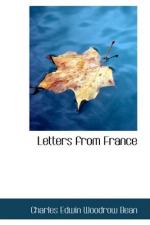For thirty minutes batches continued to come up. We could see them building up a line a little farther up the hill, where another bank gave cover. Then movement stopped and our heavy shell-bursts in La Boiselle began again. The whole affair was being repeated a step farther forward. The last we saw was the men leaping over the bank and down into the space between them and the village.
This morning we went to the same view point. The firing had gone well beyond Fricourt Wood. They were German shells which were now falling on the smoking site of La Boiselle.
On the white bank there still lay twelve dark figures.
CHAPTER XIII
THE DUG-OUTS OF FRICOURT
France, July 3rd.
Yesterday from the opposite slope of a gentle valley we watched Fricourt village taken. This morning we walked down through the long grass across what two days ago was No Man’s Land into the old German defences. The grass has been uncut for two years on these slopes, and that is why there springs from them such a growth of flowers as I have rarely seen. I think it was once a wheat field that we were walking through. It is a garden of poppies, cornflowers, and mustard flower now.
Half-way down the slope we noticed that we were crossing a line which seemed to have been strangely ruled through the wheat field. It was covered with grass, but there was a line of baby apple trees on each side of it. It took one some seconds to realise that it was a road.
We jumped across trench after trench of our own. At the bottom of the valley we stepped over a trench which had a wire entanglement in front of it. It was the old British front line. The space in front of it had been No Man’s Land.
Some of our men were still lying where shrapnel or rifle fire had caught them. By them ran another old road up the valley. Beyond the road the railway trucks were still standing as they have stood for two years in what once was Fricourt siding. The foundations of Fricourt village stood up a little beyond, against the dark shades of Fricourt Wood. Immediately before us, in front of this battered white ash heap, were the remains of the rusted wire which had once been the maze in front of the German line.
We found fragments of that wire in the bottom of the trenches themselves; lengths of it were lying among the shattered buildings behind the lines. The British shells and bombs must have tossed it about as you would toss hay with a rake. In the tumbled ruins behind the lines you simply stepped from one crater into another. Into many of those craters you could have placed a fair-sized room. One big shell, and two unexploded bombs like huge ancient cannon balls, lay there on a shelf covered with rubbish.




